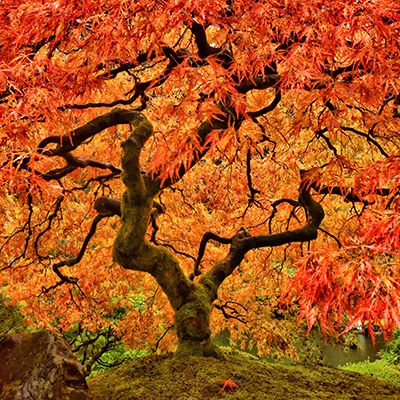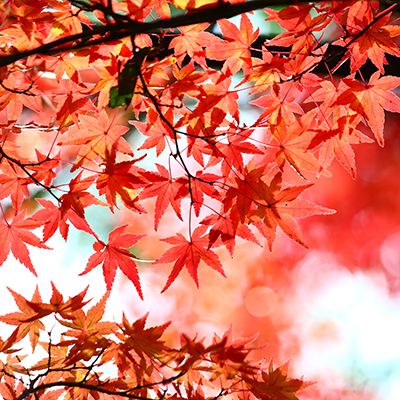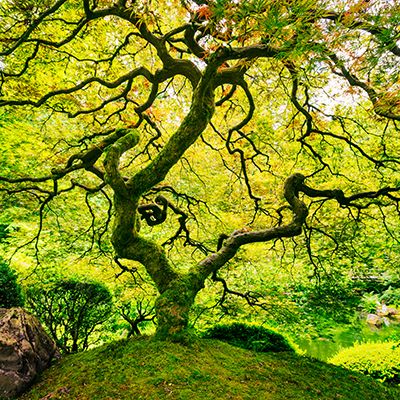


Japanese Maples
General Information
Japanese Maples have been in cultivation since the seventh century. Native to Japan and Korea, they constitute some of the world’s most beautiful deciduous trees and shrubs. Prized for their unique leaf shapes, from the palmate types to the cut-leaf types, both spring and fall foliage color and their multi-trunked forms, Japanese Maples make fine focal points in the landscape. Slow to moderate growers, upright varieties tend to reach upwards of 20-25 feet tall and wide, and the weeping varieties tend to reach 12-15 feet tall and wide. More dwarf varieties exist as well.
Varieties
There are over 250 cultivars of Japanese Maples. General categories include upright and weeping forms and the palmate, strap-leaved and cut-leaved varieties. Spring color in most varieties is reddish-pink to pink. Summer colors range from burgundy to green to variegations of green, pink and white or cream. Fall colors can be yellow to orange to deep red-orange to red; again, depending on variety.
Landscape Uses
You can use Japanese Maples effectively in front of north and east walls, in entryways and as small lawn trees. They are attractive in groves (like birches) as woodland plantings. For a natural effect, try setting out plants of different sizes with varying spacing. Japanese Maples are good as background plants for moisture-loving plants such as ferns and azaleas and alongside ponds. They also make excellent container plants and can be placed on patios or in entryways. It is important to place trees in locations where they will not receive hot sun and strong wind.
Light
Because we incur scorching summer heat, we generally recommend locating Japanese Maples in morning sun. This is especially true of cut-leaf and weeping varieties. The upright varieties, especially the palmate types, however, may withstand afternoon sun, given proper irrigation. During our hottest summers, you may note that the leaves on the periphery of the canopy succumb to leaf-scorch, whereby leaves turn brown and eventually drop. The tree will generally re-leaf, but repeated scorch may lead to twig dieback on the top of the canopy. This dieback does not compromise the health of the tree, but may be an aesthetic consideration.
Water
As understory trees, Japanese Maples are accustomed to moist conditions, created by duff on the forest floor and shading from the primary canopy. You should consider mulching with Master Nursery® Forest Bark, Gold Rush or Forest Blend to help preserve moisture in the root zone. Mulches should not touch the tree trunk nor be placed within 3-6 inches of the trunk.
Planting & Fertilizing
Like azaleas, rhododendrons, camellias, and hydrangeas; Japanese Maples prefer well-drained, acidic soils. In order to boost acidity in the soil, use one-third acid planting mix or planting mix to two-thirds of your native soil. Mulching after planting and annually with these soil mixes or with the mulches mentioned above will also contribute to soil acidity.
Fertilize your maples at the drip line with Master Nursery® Camellia, Azalea and Gardenia Food about Memorial Day and Labor Day.
To plant a Japanese Maple, follow the directions as outlined in our Planting Trees and Shrubs Care Guide. Briefly, you dig a hole at least 21/2 times the diameter of the root ball and 1 to 2 inches less deep than the height of the root ball.
The soil removed from the hole is mixed with Master Nursery® Gold Rush one-third the volume of the native soil. Your next step is to backfill with this same mixture and Master Nursery® Master Start. Make sure the graft union (if your tree is a named variety) is at least 6 inches above the surface of the soil or that the top of the root ball is slightly above the level of the soil.
This will prevent water from pooling around the trunk. Build a basin around the tree that extends out to the edge of the branches; if your tree is in a burlap bag, you can plant this directly into the ground, but be sure to cut the twine away from the trunk.
You may also consider planting your tree on a mound or in a decorative raised bed. This will help facilitate drainage. It is imperative that you locate your tree in a well-drained area of the yard, as trees can be susceptible to a host of fungal problems that proliferate in soils that don’t drain well.
For containers choose varieties that stay small and plant with Acid Planting Mix. Water at least every 4 to 5 days during the summer months. For trees in containers fertilize with Master Nursery® Camellia, Azalea, and Gardenia Food or with Gardner & Bloome® Rhododendron, Azalea & Camellia Fertilizer once a month from March to October. Trees in the ground are fertilized around Memorial Day and Labor Day.
Pests and Diseases
As mentioned above, maples with delicate leaves (cut leaf varieties) are susceptible to leaf scorch. On hot windy days, the leaves dry out faster than the roots can supply water. The leaves turn brown and crispy around the edges, if they continue to dry out; the entire leaf turns brown and drops off. The finer the leaf and the hotter and more windy the environment, the more severe will be the scorch.
Occasionally, aphids or a caterpillar will attack a maple, but usually not severe enough to use a pesticide.
Verticillium wilt is a common fungus disease which attacks maples (and many other plants).& The usual symptom is die-back of twigs or branches in various places on the tree. The die-back can progress until an entire branch is dead. The fungus is in the soil all over the Peninsula and proliferates in damp soil. Never let sprinklers wet the trunk of the tree and don’t water the tree if the top 3-4 inches of the soil is moist. When you do water, be sure it soaks down 12 to 18 inches. Prune out any dead branches and fertilize monthly with a high Nitrogen fertilizer such as lawn fertilizer.